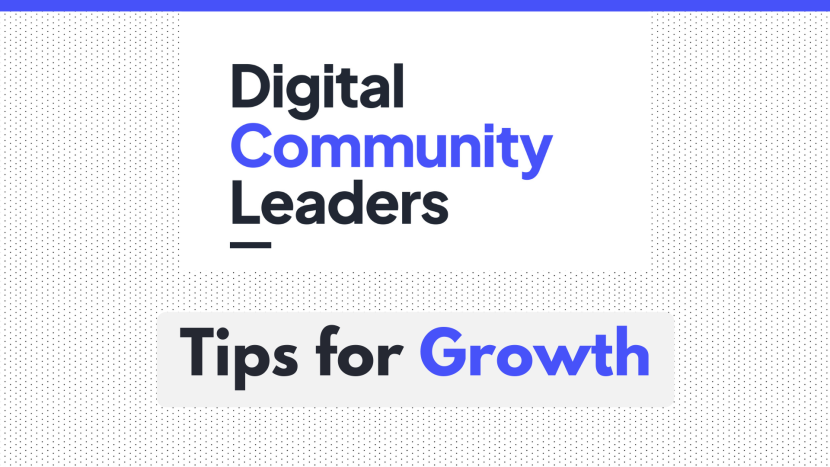Community Leaders Number One Tip for Growth

Over the past few months, I've spent a number of hours talking to various community managers with a range of experiences. One of the questions I asked each of them, was for their number one tip when it comes to growing a community.
Naturally, there are a number of variables which could affect the route a community would go down to achieve growth. Techniques can depend on the size, purpose or members of a respective community.
In this article, I'm going to collate some of my favourite answers which could inspire new ideas for community leaders across the industry.

“If you're focussed on growth, make sure you're focussed on growth for the right reasons. Don't be focussed on growth simply for growth's sake.”
Start with the Strategy
An effective starting place can be the "heart" of the community, as the healthiest growth occurs from its foundation.
People want to know that a community is for people like them. This sense of belonging is what draws people towards a common place.
Having a clear strategy to draw people in can encourage participation - a driving force towards a thriving community.
“You don't just want to be feeding a community, you need to actually engage it and encourage people to give back and participate.”
Focus on Enthusiasm
It's easy to think that community growth should start from the ground up, but sometimes a different perspective is more productive.
Rather than focussing on community members who aren't interacting, it's often easier to increase engagement from those who are already engaged.
These responsive members can be asked for feedback and suggestions which will further improve their experience. Off the back of this, it's very likely that more referrals will enter in.
“It's always much easier to keep the happy people happy and make them happier, then to figure out why there are lurkers or silent people within the community.”
Purpose-Driven Community
One common suggestion by a number of the experts I spoke to was to have a clear and concise purpose in which the community strives towards. Purpose gives members an interest, fostering a retentive culture. High retention then leads to growth through word-of-mouth, and outsiders can be enticed by the coherent community purpose.
This organic method of growth can be highly beneficial, as the people that existing members invite in will naturally be like-minded. This can only add to the retention, magnifying the purpose and motivating everyone to continue working towards it.
“Your approach to growth should start with making sure that your community is fulfilling its purpose.”
In-Person Conversation
Of course, the majority of these communities exist primarily in the digital space, and naturally a lot of the interactions are held online. Whilst growth can be achieved through online networking, this approach is second best to real life, face-to-face exchanges.
From hosting an event, to meeting people within your network for a coffee, there are numerous ways to connect with people - and it can go a long way. Real life conversation ignites enthusiasm and a greater support for your ideas, as these connections feel more involved and valued.
“First you need people that you already know are going to join in. This can be done through personal outreach to your network. ”
Data Analytics
Most community managers have access to data and statistics around the behaviours of their community members through the platforms they're using.
This raw data can be converted into actionable insights and it can be crucial when keeping track of habits.
From there, it's easier to forecast the trajectory of potential growth and to double down on the things which are spiking the interest and engagement of your members.
“With regards to growth, one of the things that I would look out for is the reporting and the data and then being strategic about what I'm spending my time on and if I should be spending it on different things.”
Community Discovery
A phrase coined by Rosie Sherry, community discovery is a useful and simplified approach to achieving growth. Just like business discovery or product discovery, it's important to discover the needs of your people.
Learning about what members are talking about and what they care about can help you as a community manager to lead them towards these things.
“This taps into the idea of me believing that community people need better vocabulary and more words to describe the work that they're doing.”
Proactive Community Management
Whilst automated features and self-sustainability have their place in a community, they don't achieve growth.
As Shane Lennox put it, the 'hard work' of talking to people is a really important tool.
A lot of people have an understandable anxiety towards reaching out to members - but there's no better way to make people feel valued.
Making a fuss over people and showing them appreciation will urge them to reciprocate, and the only cost of this approach is your time and effort.
“A lot of people say they want their community to be organic, which basically means that they don't want to do anything and they want their community to happen magically.”
The first season of the Digital Community Leaders Podcast was packed with insight and expert advice from a whole host of community managers with a range of experience.
It's not too late to check out these episodes - all 13 episodes are still available across all streaming platforms, as well as video versions on YouTube. Be sure to listen!
More Articles

When to Build Your Own Membership Platform (and When Not To)
I’ll let you in on a secret, not every membership organisation needs a bespoke membership platform.

Design for AWE
Anchor. Wonder. Connection. The blueprint for unforgettable memberships.

Community building - the LEGO way
I recently had the chance to speak with Jake McKee, who is a principal consultant, who has worked with or for the likes of LEGO, Apple and many more.

